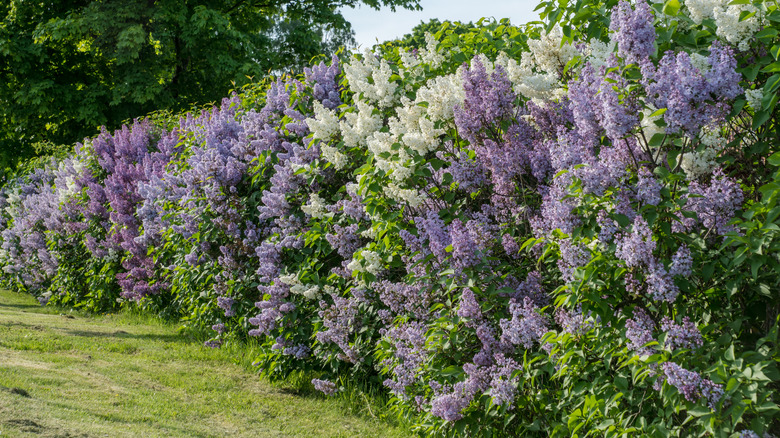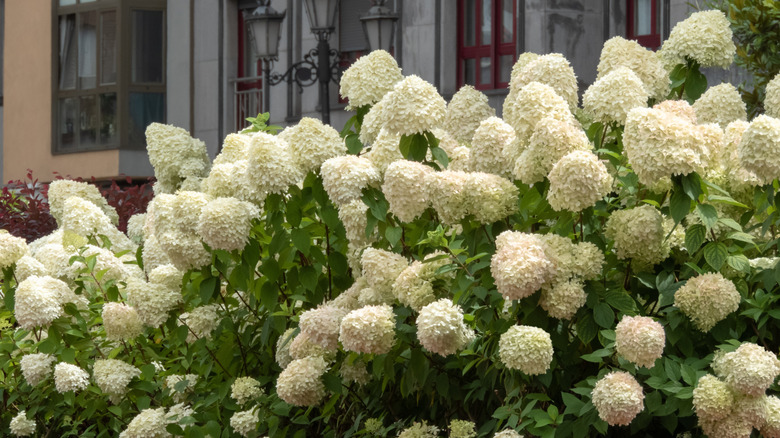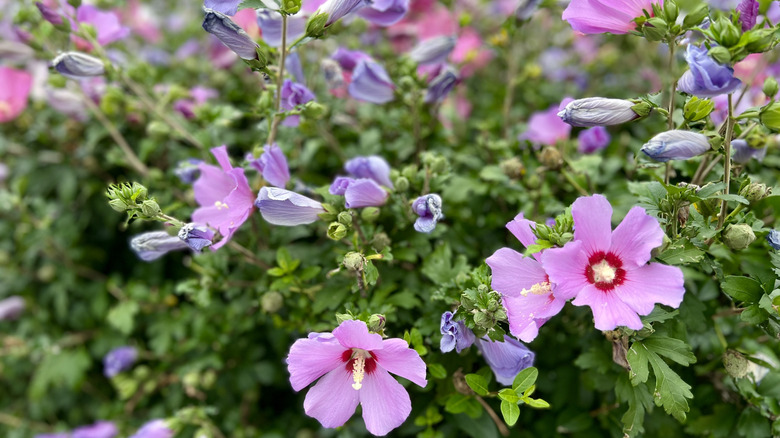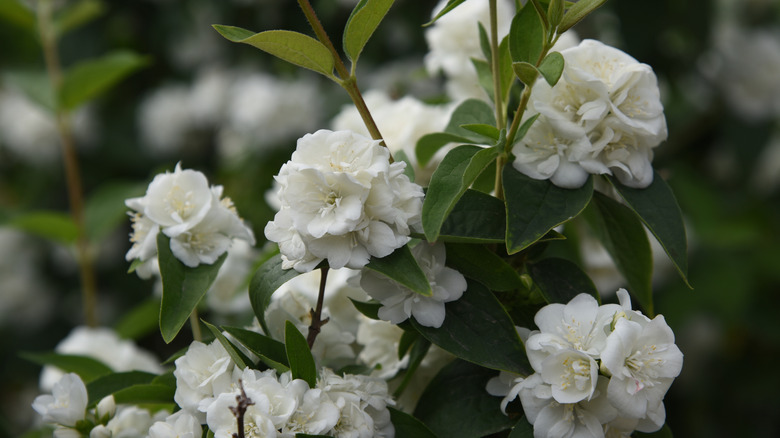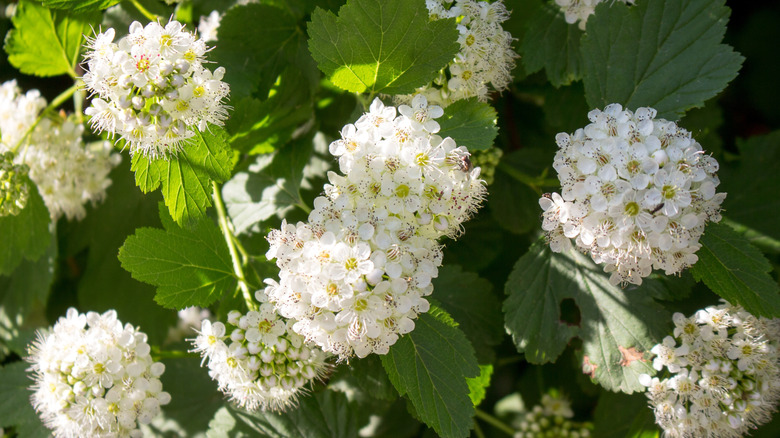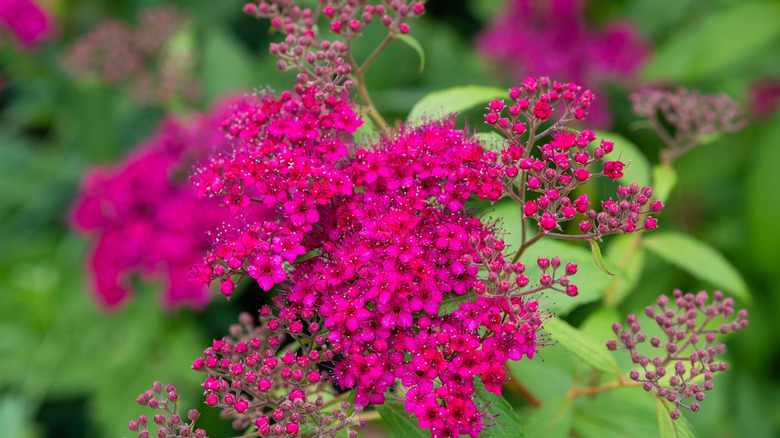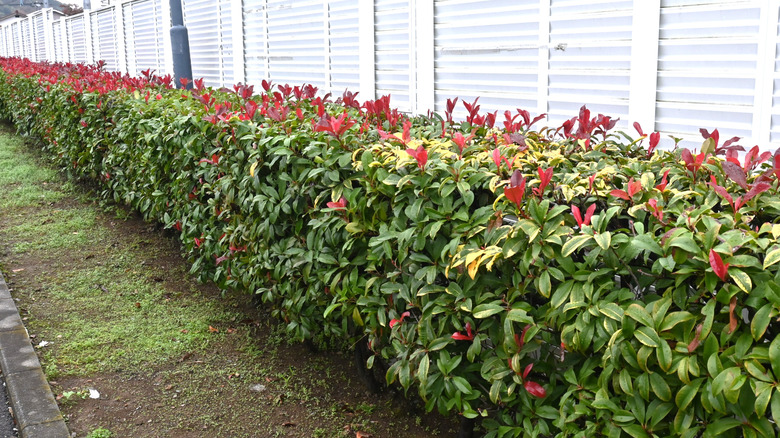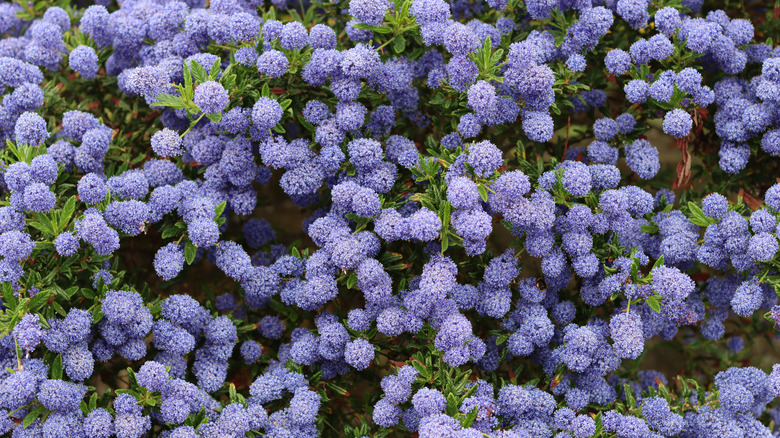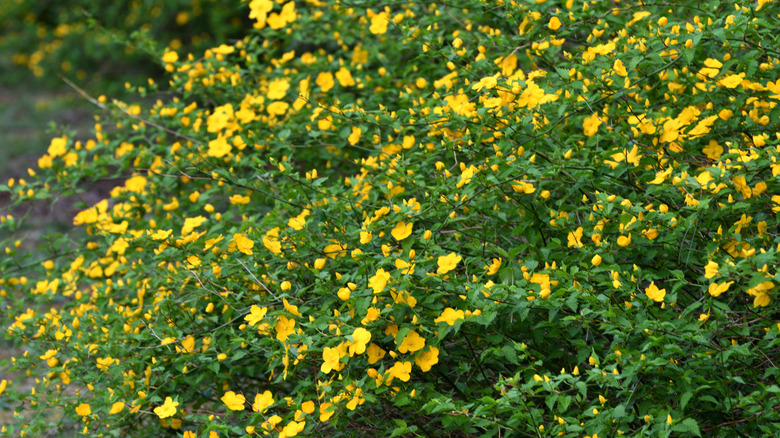Fast-Growing Flowering Shrubs To Add Color And Privacy To Your Yard
We may receive a commission on purchases made from links.
If you want your yard to feel less like a fishbowl and more like your own secluded sanctuary without waiting a decade or spending a fortune on mature plants, you need something that grows fast and knits itself into a beautiful screen. That doesn't necessarily mean you just want a wall of conifers, though. I personally like my garden to have color and interest all year, and that extends to hedging, screening, and privacy plantings.
There are plenty of fast-growing flowering shrubs that can add attractive foliage and blossoms to your garden while giving you privacy, and as a master gardener, I've made a list of those that will rapidly grow and give you color and screening. The trade-off, though, with many of these is that you'll need to water them deeply and feed them carefully to avoid weak, shaggy, or leggy growth in their first few seasons. You'll also need to engage in some thoughtful, considered pruning and topping to keep growth steady and dense rather than open and sprawling.
The plants you choose will depend on how much privacy you want and where you're planning to plant. If, for example, you want to screen a neighbor's window that looks straight into your bedroom, you'll need something big and evergreen to maintain your privacy year-round. If you're just trying to soften the edges of a sterile-looking fence or screen a pathway down the bottom of the yard that you really only use in summer, a deciduous flowering shrub will do the job beautifully.
Forsythia gives you an early spring wall of gold
Forsythia bursts into wonderfully bright flowers very early in spring, before most other shrubs have even started to bud up. The flowers appear in huge numbers on bare stems, before the leaves appear. If you plant forsythia in October, you'll have flowers by the following spring. While the standard bushy variety generally only reaches 6 feet tall and wide, some hybrids, like 'Spectabilis' or 'Goldrausch', have been specifically bred as hedging and screening plants, and can reach a spread and height of up to 10 feet in just a few years if you treat them well. 'Intermedia' can also reach a height of 10 feet and achieve an impressive 12-foot spread.
The showy flowers appear in March and April, and overall, this deciduous shrub requires minimal maintenance. You will need to prune in spring after the flowers drop, or you'll get rampant and untidy growth. It's also fairly tolerant of a wide range of soil conditions, and it's resistant to deer browsing, too, so it's a great choice if you have problems with the local deer population using your yard as their personal snack bar. Forsythia grows best in full sun but can handle partial shade.
I like forsythia because it's also tolerant of black walnut, which releases a compound called juglone into the soil. This causes many plants to fail to thrive and exhibit stunted growth, no flowers, weak leggy growth, or yellow foliage. Forsythia, however, does not react to this compound and grows regardless of the presence of black walnut. In some cases, though, forsythia starts to fail to flourish every three to four years, in which case you cut it right back just a few inches from the ground to let it rebound and rejuvenate.
Panicled hydrangeas bulk up quickly
Panicled hydrangeas grow quickly into informal hedges or dense shrubs in zones 3 to 8. The density of the foliage and the huge conical flower heads make this a great choice for seasonal privacy. It's deciduous but has a long season and reaches up to 8 feet tall and wide. If you go with a cultivar like 'Limelight', you'll get an interesting display of flowers that start lime green, and, as they mature, move to near-white, then develop a pastel pink hue that eventually deepens in autumn as the flowers reach maturity. And, if you leave them alone, the spent heads create real interest with their conical shape right through winter, and it also makes them a bit more useful as a screen.
However, this one is particularly dangerous if you have pets or young kids, and shouldn't even be handled without gloves. So be cautious. Thankfully, it doesn't need much pruning or maintenance, but if you do decide to cut it back or shape it, remember to clear away the clippings right away, as even those are dangerous. It's pretty robust, too, and will cope with most soil conditions as long as it doesn't stay soggy or get really dry, as it's not drought-tolerant. It will grow in full sun or partial shade, and can cope with exposed locations.
Weigela produces quick mounds with trumpet flowers
Weigela is a pretty, fast-growing deciduous shrub that has a really interesting growth habit. It produces long, arching stems that form a tall dome, with some cultivars reaching 10 feet tall and wide in just a few years. The flowers are plentiful and trumpet-shaped, and they bloom in late spring through early summer. A few varieties have a second short bloom period in late summer or early fall. Depending on the cultivar, flowers are white, pink, red, yellow, or purple. Some also have speckled throats.
These domed shrubs are tolerant of all but the driest and wettest soils and can grow in full sun or dappled shade, but they don't do well in deep shade. Varieties with variegated leaves actually do better with light shade than full sun, as too much intense sunlight can cause leaf scorch. For a variety that can get really tall, go with Weigela coraeensis 'Alba' or Weigela florida 'Alexandra'. I also really like 'Red Prince' for its bright red trumpets, although this cultivar generally only grows to around 6 feet. Weigela is a dense privacy shrub that's good to add in front of taller evergreens, as it'll provide lots of color, interest, and density from spring to fall, but once the leaves drop, the evergreens behind still provide you with ample privacy.
Rose of Sharon provides tall summer privacy
A variety of hibiscus, the Rose of Sharon, is hardy in zones 5 through 8. It's deciduous, so it won't give you total privacy when it drops its leaves, although it can behave as an evergreen in warmer climates. It is resistant to deer, tolerates drought and black walnut, and will even grow in clay soil. It can also cope with thin, poor soils, although it won't grow as densely or quickly in soil lacking in nutrients. Rose of Sharon can reach up to 12 feet tall with a spread of 10 feet.
Before you plant, though, check whether rose of Sharon is considered invasive in your state. It isn't a native species and does tend to spread, so it is reported as invasive in some areas. You can, however, get sterile cultivars, like 'Sugar Tip' or 'Pollypetite', that don't self-seed and are therefore considered safe. This one doesn't need too much maintenance, but you may want to prune in late winter to maintain its shape. This plant grows fast and will bloom from spring all the way into fall. The flowers are large and open with a striking yellow protruding stamen. Bright pink flowers are among the most popular cultivars, but you can also find reds, blues, and whites.
Butterfly bushes grow incredibly fast
Butterfly bushes grow super-fast. However, the common butterfly bush, or Buddleja davidii, is considered invasive in some states, so check before you plant or choose a sterile cultivar. But other types, such as Buddleja 'alterniflora' and Buddleja 'fallowiar' are generally deemed safe. Depending on the cultivar, butterfly bushes can reach 12 feet tall and 15 feet wide. They tend to have a sprawling habit, so they don't give the densest protection, but they are beautiful and vigorous and make great screening to soften fences. As the name implies, they also attract hordes of butterflies that feast on the nectar from the purple or pink flowers.
Buddleja is winter-hardy in USDA hardiness zones 5 through 9. However, in zones 5 and 6, unless it has some protection, such as being planted by a warm, south-facing wall, it will die back to the ground in winter but burst back to life in spring. Where it lasts all winter, you may want to prune it to keep it in check, as it can get leggy and "wild" fast.
This bushy deciduous plant grows pretty much anywhere and is tolerant of most soil types. It can even cope with salt and high humidity. It's also drought-tolerant and resistant to deer. So it's a solid option if you have thin, clay, or otherwise poor or difficult soil. It flowers best in full sun but can still cope with moderate shade. It will, however, fail to thrive in constantly wet soils.
Mock orange grows into a fragrant screen
Mock orange is another deciduous shrub in the hydrangea family, and it's hardy in zones 4 to 8. I'm a fan of mock orange for hedging as it grows up to 12 feet tall and wide. It has beautiful, showy white flowers with a heady, distinctive citrus scent. Mock orange is very attractive to butterflies and pollinators, too, when it blooms between May and June.
Mock orange, like this Illuminati Spice 4" mock orange plant, requires little maintenance, but it isn't drought-tolerant, so, at least until it gets established, you'll need to water it deeply from time to time. It's also a good idea to prune out weak or overcrowded stems after flowering to encourage strong, healthy growth. Do note, though, that it flowers on stems from the previous year, so be careful with what you cut. It does only have a short flowering period, but the flowers are so plentiful and wonderfully scented that it's worth growing. Especially if you're creating a little sanctuary where you can sit and enjoy your morning coffee surrounded by the scent of oranges.
Ninebark gives rapid coverage with bold foliage
A fast-growing deciduous shrub, ninebark is a good choice for medium-size hedging, as it grows up to 8 feet tall and wide. With ninebark, you'll see clusters of small white to pale pink flowers in May to June, followed by red fruit after the blooms are spent. Although it's deciduous, it is actually hardy down to zone 2, so it performs well even in colder climates.
These plants are bushy and produce suckers, so you'll want to keep on top of them to avoid spread. Ninebark has an informal growth habit and so is best suited to cottage-style gardens. To prune, tackle them shortly after flowering. Ninebark is pretty tough, can tolerate acidic or alkaline soils, and is drought-tolerant, too. Additionally, it can cope with clay and shallow soils, and is a good choice in areas where you're trying to combat erosion. While the white flowers aren't overly impressive, the foliage is. Varieties like 'Diabolo', 'Summer Wine', 'Dart's Gold', and 'Luteus' have striking foliage in a variety of colors, from golden yellow to deep purple.
Japanese spirea creates a quick-growing low hedge
Japanese spirea typically grows to about 5 feet, although some cultivars may reach 6 feet, so it's not the tallest. But it is fast-growing and creates a beautifully dense hedge with a gorgeous show of flowers from late spring to midsummer. Some cultivars also produce a second flush of blooms in late summer or early fall, especially if you deadhead the plant as the first clusters die off. The large, flattened flower clusters can reach an impressive 8 inches across, and you'll find butterflies and other pollinators flock to them. It's deciduous, so it drops foliage in late fall, and is hardy in zones 3 to 8.
This member of the rose family is resistant to deer, tolerates urban conditions, including thin, nutrient-poor soil. It can also cope with heavy clay soil. Because of its fast growth habit and root matrix, it's also a good option for erosion control. It is, however, considered invasive in some states, as it aggressively self-seeds and puts off suckers that quickly anchor and produce new plants. Thankfully, there are plenty of non-invasive cultivars to choose from, including 'Crispa', 'Neon Flash', and 'Dart's Red'. All three of these are sterile, so they won't spread by seed.
Elaeagnus is a tough, fast-growing, scented evergreen
Elaeagnus is a dense, evergreen shrub that produces small, showy, tubular, fragrant flowers in fall. It reaches 10 feet tall and wide and adds winter interest to your garden due to its evergreen nature and pretty orange fruits that provide food for birds. It's hardy in zones 7 to 9, with some cultivars managing as a deciduous shrub down to zone 4, and it's somewhat tolerant of drought once established. Elaeagnus is pretty and tough and can grow anywhere from full sun to shade. Eleagnus can also handle poor, infertile, and clay soils as long as it doesn't stay perpetually wet.
Because of its height and evergreen nature, elaeagnus gives you privacy all year and makes a great hedging or screening plant. Plus, because it's a hardier shrub, it'll work well in exposed sites as a wind break for other, more sensitive plants. However, many of these cultivars are considered invasive in a number of states, so be sure to check before you plant. You can also choose an infertile cultivar like Ebbinge's 'Silverberry'.
Photinia is a colorful evergreen for year-round privacy
The best-known Photinia is the striking 'Red Robin' cultivar. Red Robin is a beautiful, bushy evergreen, so it's a great choice for year-round privacy. It reaches an impressive 15 feet tall and wide. It has fragrant, showy flowers and is resistant to drought. Photinia performs best in full sun but can also tolerate partial shade. It only flowers in spring, then produces red ornamental fruits. The evergreen foliage starts off bright red but turns dark green as it matures.
Photinia 'Red Robin' is only hardy in zones 7 to 9, but with winter protection and sheltered positioning can survive in zone 6, too. While its winter hardiness is limited, in those zones it provides lots of privacy, even through winter, especially if you buy and plant multi-packs of live plants like this 10-pack of photinia red robin from Florida Foliage. This is one to pace along property lines or away from areas where you spend a lot of time, though, as many people find the scent of the flowers unpleasant, similar to hawthorns. To thicken this shrub up and to encourage a second flush of red foliage, prune it in the spring after the first flush of red starts to fade to green.
Californian lilac is a fast-growing evergreen shrub
The Californian lilac grows rapidly and has a dense, bushy habit in zones 7 through 10. It produces large clusters of tiny blue, pink, or white flowers in spring. It's also evergreen, so it provides ample screening and privacy all year round. It requires positioning in at least a somewhat sheltered spot, as it doesn't do well with excessive winds. This lilac grows up to 8 feet tall and spreads up to 12 feet. The flower clusters attract all kinds of pollinators and hummingbirds, so this is a good choice for supporting wildlife and boosting biodiversity.
Californian lilacs like full sun and can cope with dry conditions, but it doesn't like to be kept too wet. I recommend Californian lilac because it can grow even in shallow, rocky soils and isn't popular with deer. But, because it puts off deep roots that help it anchor in tough conditions and be resistant to drought, the plant is challenging to remove once it matures.
Kerria gives you big flowers and fast growth in partial shade
Kerria, or Japanese kerria, is a deciduous shrub that can reach 10 feet tall and wide and will give you bright yellow rose-like flowers from April to May in zones 4 to 9. 'Plentiflora' is one of the most popular cultivars, as it produces 2-inch pom-pom-like double blooms. Although it's not evergreen, it's great for screening in urban environments that tend to have nutrient-poor and thin soils. In challenging conditions, this shrub is a strong contender because it can tolerate drought, wet feet, and even heavy shade. Plus, deer dislike it, so overbrowsing is not a problem.
In some states, this plant is classed as invasive, and there are no truly sterile cultivars, as it spreads by suckering. So, even if it's not listed as invasive where you live, you'll want to keep the suckers in check so it doesn't spread too aggressively. When you prune, remember that it flowers on the previous year's stems, so don't remove first and second year growth or you'll reduce the number of blooms.
